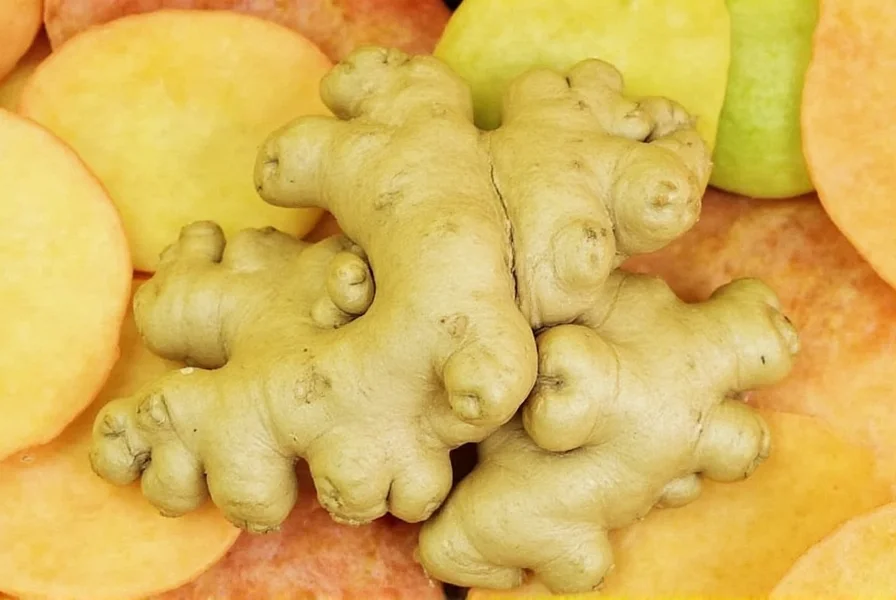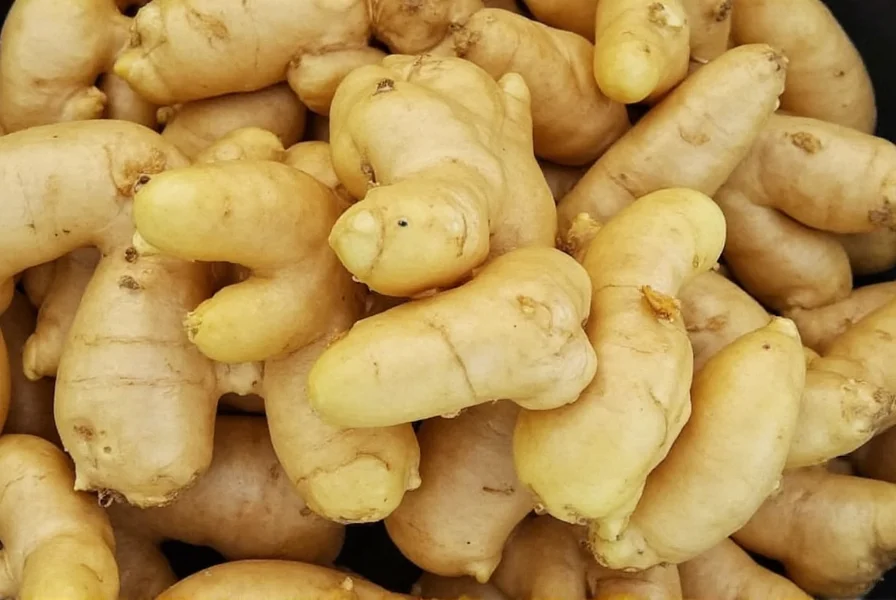Ginger Star represents one of the most reliable ginger cultivars for cultivation across various growing zones. Unlike generic supermarket ginger that often struggles to sprout, this specialized variety has been selectively bred for vigorous growth and consistent performance in home gardens and small-scale agricultural settings.
Botanical Characteristics of Ginger Star
Ginger Star (Zingiber officinale 'Ginger Star') belongs to the Zingiberaceae family and shares the basic botanical structure of other ginger varieties while exhibiting distinctive traits. The plant typically reaches 3-4 feet in height with lush green foliage and produces yellow-flushed flowers under optimal conditions, though many growers cultivate it primarily for its underground rhizomes rather than ornamental value.
What sets Ginger Star apart from common ginger varieties is its rhizome structure. The rhizomes feature:
- Plump, well-formed fingers with minimal branching
- Thin skin that requires less peeling than commercial varieties
- High moisture content (approximately 80-85%)
- Bright yellow interior with balanced pungency
- Extended shelf life compared to standard ginger
| Characteristic | Ginger Star | Common Grocery Store Ginger |
|---|---|---|
| Rhizome Shape | Plump, uniform fingers | Irregular, stringy |
| Sprouting Reliability | 90-95% | 30-40% |
| Flavor Profile | Balanced heat with citrus notes | Variable, often fibrous |
| Growth Cycle | 8-10 months | N/A (not intended for planting) |
Optimal Growing Conditions for Ginger Star
Ginger Star thrives in warm, humid environments but demonstrates greater adaptability than many ginger varieties. Successful cultivation requires attention to several key factors that influence the quality and yield of your harvest.
Soil requirements represent the foundation for healthy Ginger Star plants. This variety prefers loose, well-draining soil rich in organic matter with a pH between 5.5 and 6.5. Raised beds or containers work exceptionally well for maintaining proper drainage, which prevents rhizome rot—a common issue with ginger cultivation. Incorporating compost or well-rotted manure before planting significantly improves both yield and flavor development.
Climate considerations play a crucial role in Ginger Star success. While ginger naturally grows in tropical conditions, this cultivar tolerates slightly cooler temperatures than many varieties. The ideal temperature range spans 75-85°F (24-29°C) during the growing season, with protection required when temperatures drop below 50°F (10°C). In temperate climates, gardeners achieve best results by planting Ginger Star rhizomes indoors 4-6 weeks before the last frost, then transplanting outdoors when soil temperatures consistently exceed 60°F (15°C).
Watering practices directly impact Ginger Star development. Maintain consistent moisture without waterlogging—approximately 1-2 inches of water per week. Reduce watering frequency during the final 4-6 weeks before harvest to encourage rhizome maturation and improve storage qualities. Mulching with straw or shredded leaves helps maintain soil moisture and temperature stability while suppressing weeds.
Ginger Star vs. Other Ginger Varieties
Understanding how Ginger Star compares to alternative varieties helps growers make informed decisions about which cultivar best suits their needs. While all ginger shares fundamental characteristics, subtle differences significantly impact cultivation success and end-use applications.
Compared to Yellow Ginger (the most common grocery store variety), Ginger Star demonstrates superior sprouting reliability and more consistent rhizome formation. Yellow Ginger often arrives at stores treated with growth inhibitors that prevent successful propagation, whereas Ginger Star rhizomes remain viable for planting without chemical treatments.
When contrasted with Blue Hawaiian Ginger, Ginger Star offers a more traditional ginger flavor profile while Blue Hawaiian features distinctive purple-tinged rhizomes and a more floral, less pungent taste. Blue Hawaiian typically requires more specialized growing conditions and produces lower yields than Ginger Star.
Ginger Star's primary advantage over generic ginger varieties lies in its predictable growth pattern and reliable harvest. Home gardeners particularly appreciate that Ginger Star rhizomes develop uniformly, making them easier to harvest and process than the irregular shapes common in other varieties.
Harvesting and Storage Techniques
Proper harvesting and storage techniques maximize the quality and shelf life of your Ginger Star crop. Unlike some ginger varieties that require precise timing, Ginger Star offers a relatively flexible harvest window while maintaining quality.
For fresh consumption, harvest Ginger Star rhizomes approximately 8-10 months after planting, when the foliage begins to yellow and die back naturally. Carefully dig around the plant to avoid damaging the rhizomes, then cut away the stems leaving about 1 inch of stem attached. Allow the harvested rhizomes to cure in a shaded, well-ventilated area for 2-3 days before cleaning.
For long-term storage, maintain Ginger Star rhizomes in a cool, dark place with high humidity (70-80%). Unlike common ginger that quickly becomes fibrous and dry, Ginger Star retains its moisture content and flavor profile for 3-4 weeks under proper storage conditions. For extended preservation, slice and freeze Ginger Star rhizomes or store them in a vinegar solution for culinary use.
Common Challenges in Ginger Star Cultivation
While Ginger Star demonstrates greater resilience than many ginger varieties, growers may encounter several challenges that affect plant health and yield. Understanding these issues helps implement preventive measures before problems become severe.
Rhizome rot represents the most significant threat to Ginger Star crops, typically caused by overwatering or poor drainage. Prevention strategies include planting in raised beds, using well-draining soil mixes, and avoiding overhead watering. If rot appears, immediately remove affected plants and improve drainage in the growing area.
Leaf spot diseases occasionally affect Ginger Star, particularly during periods of high humidity. These fungal issues manifest as brown or yellow spots on foliage. Manage by removing affected leaves promptly, improving air circulation around plants, and applying organic fungicides if necessary.
Pests such as aphids and spider mites may infest Ginger Star plants, especially in container settings. Regular monitoring and immediate treatment with insecticidal soap or neem oil typically controls these issues before they significantly impact plant health.

Culinary and Medicinal Applications
Ginger Star's balanced flavor profile makes it exceptionally versatile for both culinary and wellness applications. The cultivar's consistent quality ensures reliable results whether used fresh, dried, or processed.
In culinary contexts, Ginger Star performs exceptionally well in both raw and cooked applications. Its moderate heat level works beautifully in:
- Freshly grated into stir-fries and sauces
- Infused in teas and beverages
- Pickled preparations
- Baking applications where consistent flavor matters
- Raw consumption in salads and sushi
For medicinal uses, Ginger Star contains optimal levels of gingerols and shogaols—the active compounds responsible for ginger's therapeutic properties. Research indicates these compounds support digestive health, reduce inflammation, and may alleviate nausea. The consistent composition of Ginger Star rhizomes ensures reliable potency for homemade remedies compared to variable grocery store ginger.

Obtaining Authentic Ginger Star Rhizomes
Securing genuine Ginger Star rhizomes requires careful selection, as many suppliers mislabel generic ginger as specialty varieties. Reputable sources include:
- Specialty ginger nurseries with documented cultivar information
- University extension programs focusing on tropical crops
- Trusted online retailers with customer reviews verifying the variety
Avoid using grocery store ginger for planting, as these rhizomes often come from varieties not intended for propagation and may have been treated with growth inhibitors. When purchasing Ginger Star rhizomes, look for plump, firm rhizomes with multiple growth eyes and no signs of mold or shriveling.
How long does it take to grow Ginger Star from planting to harvest?
Ginger Star typically requires 8-10 months from planting to harvest. The exact timeframe depends on growing conditions, with warmer climates potentially yielding slightly faster. You'll know it's ready when the foliage begins to yellow and die back naturally.
Can I grow Ginger Star in containers indoors?
Yes, Ginger Star grows well in containers indoors. Use a pot at least 12 inches deep with excellent drainage. Place in bright, indirect light and maintain consistent moisture. Indoor growing allows year-round cultivation in temperate climates, though yields may be slightly smaller than outdoor-grown plants.
What makes Ginger Star different from regular grocery store ginger?
Ginger Star is a specific cultivar bred for reliable growth and consistent quality, while grocery store ginger often comes from varieties treated with growth inhibitors that prevent successful propagation. Ginger Star produces plump rhizomes with more uniform shape, better flavor, and higher sprouting success rates (90-95% compared to 30-40% for typical store ginger).
How should I store harvested Ginger Star rhizomes?
Store Ginger Star rhizomes in a cool, dark place with high humidity (70-80%). They maintain quality for 3-4 weeks under these conditions. For longer storage, slice and freeze the rhizomes or preserve them in vinegar. Avoid refrigeration, which can cause premature spoilage in ginger.
Is Ginger Star suitable for medicinal use?
Yes, Ginger Star contains optimal levels of gingerols and shogaols—the active compounds responsible for ginger's therapeutic properties. Its consistent composition ensures reliable potency for homemade remedies, making it particularly valuable for digestive health support, inflammation reduction, and nausea relief compared to variable grocery store ginger.











 浙公网安备
33010002000092号
浙公网安备
33010002000092号 浙B2-20120091-4
浙B2-20120091-4